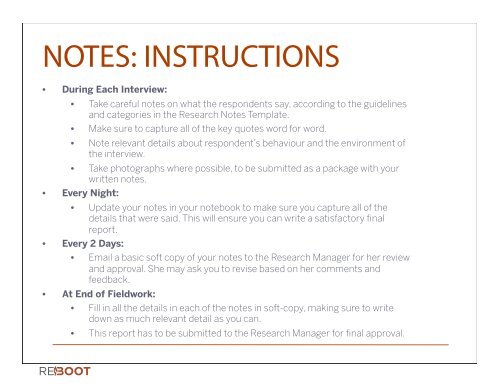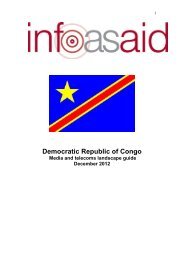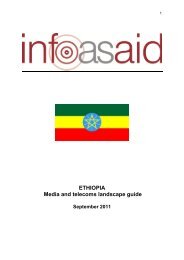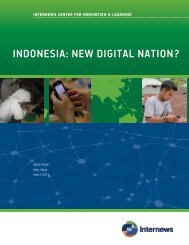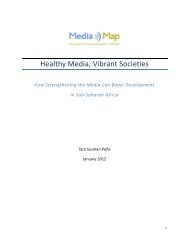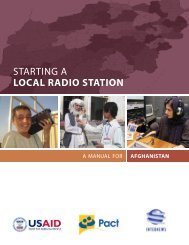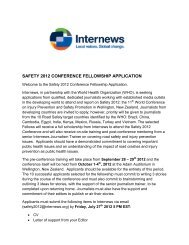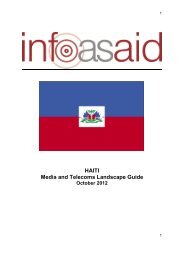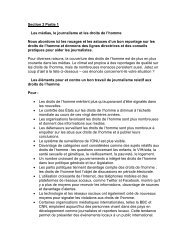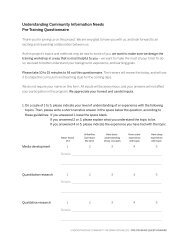note-writing-instructions - Internews
note-writing-instructions - Internews
note-writing-instructions - Internews
- No tags were found...
Create successful ePaper yourself
Turn your PDF publications into a flip-book with our unique Google optimized e-Paper software.
NOTES: INSTRUCTIONS• During Each Interview:• Take careful <strong>note</strong>s on what the respondents say, according to the guidelinesand categories in the Research Notes Template.• Make sure to capture all of the key quotes word for word.• Note relevant details about respondent’s behaviour and the environment ofthe interview.• Take photographs where possible, to be submitted as a package with yourwritten <strong>note</strong>s.• Every Night:• Update your <strong>note</strong>s in your <strong>note</strong>book to make sure you capture all of thedetails that were said. This will ensure you can write a satisfactory finalreport.• Every 2 Days:• Email a basic soft copy of your <strong>note</strong>s to the Research Manager for her reviewand approval. She may ask you to revise based on her comments andfeedback.• At End of Fieldwork:• Fill in all the details in each of the <strong>note</strong>s in soft-copy, making sure to writedown as much relevant detail as you can.• This report has to be submitted to the Research Manager for final approval.
NOTES: SECTIONS1. Interview Code: Location - Date - Interview # - Type of Interaction - Sex - Description• INT: Interview• ST: Service Trial• OBS: Observation• SHA: Shadowing2. Interviewee: Basic description: Age, gender, profession, economic class, family, otherdemographic indicators. To help us and you remember this interview.3. Location: Where the interview took place.4. Observations: General impressions about the respondent or environment, especially factorsthat may impact how we interpret the responses. (eg. Were there other people around? Didthey seem nervous?)5. Theme: Key theme or topic of the research, as well as new themes that may emerge over yourfieldwork. Feel free to create new sub-themes.6. Notes: Documentation of what respondent said in relation to theme. These should be justplain <strong>note</strong>s based on what they said. Do not include any analysis based on what you think.7. Quote: Exact quotes (word-for-word) on what respondent said in relation to theme. The rightquote can be very revealing. (Consider including anything that was particularly surprising,interesting, or new to you.)8. Analysis: Your own interpretation or analysis of the the <strong>note</strong>s or quote. (Think about: Is theredeeper meaning? Is there inaccuracy? Is there something else we should know?)
1. Interview Code: Location - Date - Interview # -Type of Interaction - Sex - Description
2. Interviewee: Basic description: Age, gender, profession,economic class, family, other demographic indicators.
3. Location: Where the interview took place.
4. Observations: General impressions about therespondent or environment, especially factors thatmay impact how we interpret the responses.
5. Theme: Key theme or topic of the research, as wellas new themes that may emerge over your fieldwork.Feel free to create new sub-themes.
6. Notes: Documentation of what respondent said inrelation to theme. Plain <strong>note</strong>s based on what they said.Do not include any analysis based on what you think.
7. Quote: Exact quotes (word-for-word) on whatrespondent said in relation to theme. The right quotecan be very revealing.
8. Analysis: Your own interpretation or analysis of thethe <strong>note</strong>s or quote. Think about: Is there deepermeaning, inaccuracy, something else we should know?


